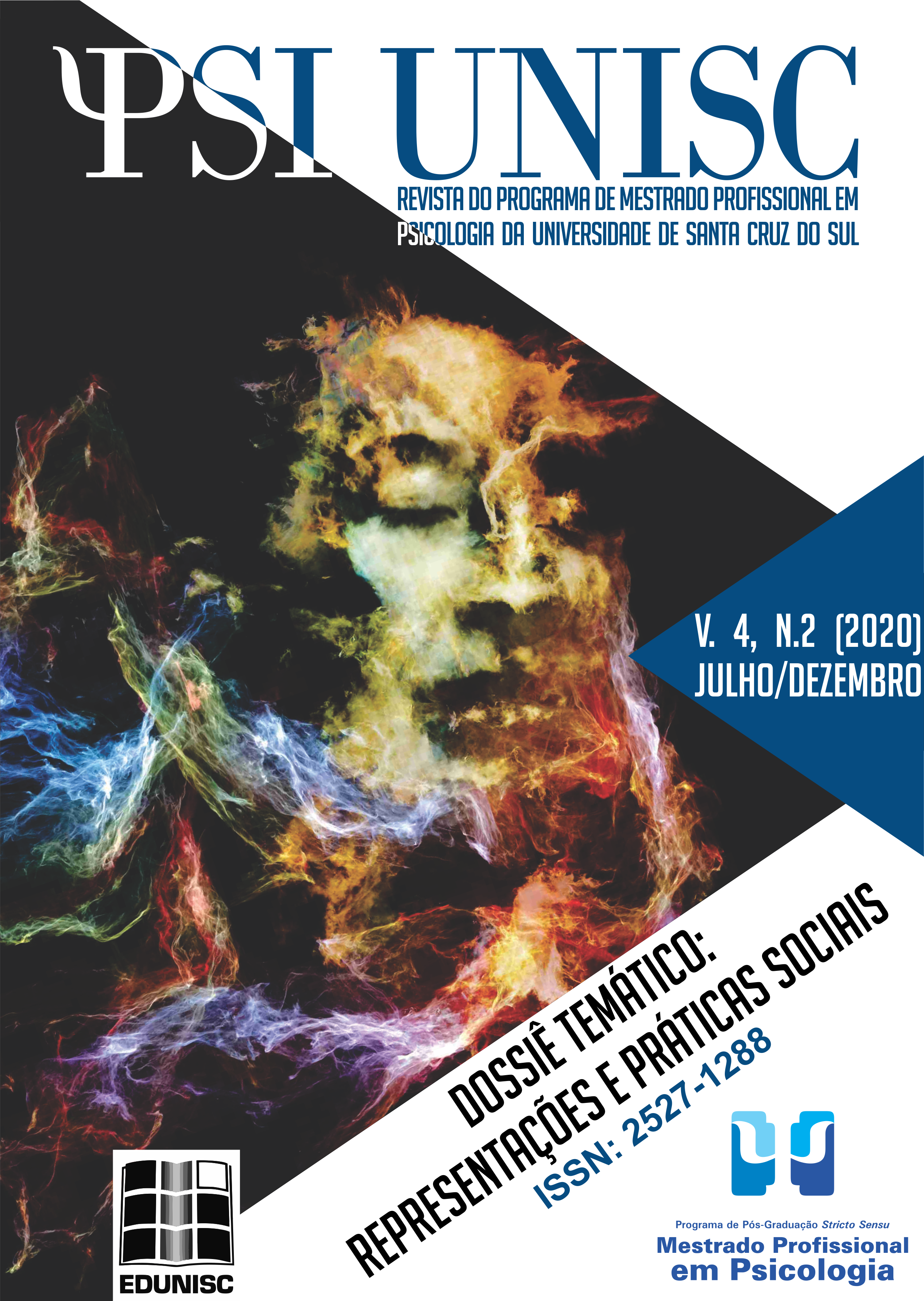Representaciones Sociales de Tatuaje para Personas Tatuadas
DOI:
https://doi.org/10.17058/psiunisc.v4i2.14945Palabras clave:
Tatuaje, Representaciones sociales, Psicologìa social.Resumen
El tatuaje ha sido uno de los fenómenos más extendidos asociados con el cuerpo hoy en día. El objetivo de este estudio fue identificar las representaciones sociales del tatuaje para personas con tatuaje. Se realizaron 36 entrevistas individuales semidireccionales, con individuos tatuados de ambos sexos, subdivididos en 12 categorías, de acuerdo con los siguientes criterios: sexo, tamaño del tatuaje y hora en que se realizó el primer tatuaje. Se realizó un análisis de contenido temático-categórico, con la ayuda del software Atlas.ti. A través del enfoque dimensional, se descubrió que el tatuaje se entiende como una forma de externalizar algún significado importante en el cuerpo, con motivos variados. Las representaciones sociales adquieren un papel central en la elaboración de formas colectivas de ver y vivir el cuerpo, diseminando modelos de pensamientos y comportamientos, considerando que la historia individual, las motivaciones y las relaciones interpersonales están impregnadas de conocimiento, creencias y valores socialmente adquiridos.
Descargas
Citas
Bardin, L. (2011). Análise de conteúdo. São Paulo: Edições 70.
Baumann, C., Timming, A. R., & Gollan, P. J. (2016). Taboo tattoos? A study of the gendered effects of body art on consumers' attitudes toward visibly tattooed front line staff. Journal of Retailing and Consumer Services, 29, 31–39. doi: 10.1016/j.jretconser.2015.11.005
Brooks, T.L., Woods, E.R., Knight, J.R., & Shrier, L.A.(2003). Body modification and substance use in adolescents: is there a link? Journal of Adolescence Health, 32(1), 44-49. doi: 10.1016/S1054-139X(02)00446-9
Burdall, O., Longworth, T., & Nyugen, D. (2014). Burns following attempted electrosurgical tattoo removal. Burns, 40(8), 61-65. doi: 10.1016/j.burns.2014.03.015
Carmen, R. A., Guitar, E., & Dillon, H. M. (2012). Ultimate Answers to Proximate Questions: The Evolutionary Motivations Behind Tattoos and Body Piercings in Popular Culture. Review of General Psychology, 16(2), 134-143. doi: 10.1037/a0027908
De Rosa, A. S. & Farr, R. (2001). Icon and symbol: Two sides of the coin in the investigation of social representations. In F. Buschini & N. Kalampalikis (Orgs.), Penser la vie, le social, la nature: Mélanges en hommage à Serge Moscovici (pp. 237-256). Paris: Editions de la Maison des Sciences de l’Homme.
DeLuca, G., Grisci, C. L. I., & Lazzarotto, G. D. R. (2018). Trabalhar e tatuar-se: estratégia de inventar a vida. Psicologia & Sociedade, 30, e170175. doi: 10.1590/1807-0310/2018v30170175
Deschamps, J. C., & Moliner, P. (2009). A identidade em psicologia social: dos processos identitários às representações sociais. Petrópolis: Vozes.
Dickson, L., Dukes, R., Smith, H., & Strapko, N. (2014). Stigma of ink: Tattoo attitudes among college students. The Social Science Journal, 51(2), 268-276. doi: 10.1016/j.soscij.2014.02.005
Doise, W. (2011). Sistema e Metassistema. In A. M. de O. Almeida, M. de F. de S. Santos, & Z. A. Trindade (Orgs.), Teoria das Representações Sociais: 50 anos (pp. 123-156), Brasília: Technopolitik.
Durkin, S. E. (2012). Tattos, Body Piercing, and Healthcare Concerns. Journal of Radiology Nursing, 31(1), 20-25. doi: 10.1016/j.jradnu.2011.09.001
Fishbein, M., & Ajzen, I. (1975). Belief, attitudes, intention and behavior: an introduction to theory and research. Reading, Massachusetts: Addison-Wesley.
Ghiglione, R., & Matalon, B. (1997). O inquérito: teoria e prática. Oeiras: Celta.
Giles-Gorniak, A. N., Vandehey, M. A., & Stiles, B. L. (2016). Understanding Differences in Mental Health History and Behavioral Choices in a Community Sample of Individuals with and without Body Modifications. Deviant Behavior, 37(8), 852-860. doi: 10.1080/01639625.2015.1060798
Jennings, W. G., Fox, B. H., & Farrington, D. P. (2014). Inked into Crime? An Examination of the Causal Relationship between Tattoos and Life-Course Offending among Males from the Cambridge Study in Delinquent Development. Journal of Criminal Justice, 42(1), 77-84. doi: 10.1016/j.jcrimjus.2013.12.006
Jodelet, D. (1984). The representation of the body and its transformations. In R. Farr & S. Moscovici (Orgs.), Social representations (pp. 211-238). Cambridge: Cambridge University Press.
Jodelet, D. (2001). Representações sociais: um domínio em expansão. In D. Jodelet (Ed.), As representações sociais (pp.17-29). Rio de Janeiro: Eduerj.
Jodelet, D., Ohana, J., Bessis-Moñino, C., & Dannenmüller, E. (1982). Système de représentation du corps et groupes sociaux (Vol. 1). Laboratoire de Psychologie Sociale: E. H. S. S.
Kemp, K. (2005). Corpo modificado, corpo livre?. São Paulo: Paulus.
Kierstein, L., & Kjelskau, K. C. (2015). Tattoo as art, the drivers behind the fascination and the decision to become tattooed. Current Problems in Dermatology, 48, 37-40. doi: 10.1159/000369180
King, K. A., & Vidourek, R. A. (2013). Getting inked: Tattoo and risky behavioral involvement among university students. The Social Science Journal, 50(4), 540-546. doi: 10.1016/j.soscij.2013.09.009
Kluger, N. (2014). Tatouages et imagerie médicale : problèmes et mythes. La Presse Médicale, 43(5), 529-533. doi: 10.1016/j.lpm.2013.07.031
Kluger, N. (2015). Pregnancies in tattooed female tattooists: an observational study. European Journal of Obstetrics & Gynecology and Reproductive Biology, 189, 112–114. doi: 10.1016/j.ejogrb.2015.03.024
Kossida, T., Rigopoulos, D., Katsambas, A., & Anderson, R. R. (2012). Optimal tattoo removal in a single laser based on the method of repeated exposures. Journal of the American Academy of Dermatology, 66(2), 271-277. doi: 10.1016/j.jaad.2011.07.024
Macedo, S., & Paravidini, J. L. L. (2015). O ato de tatuar-se: gozo e identificação o ato de tatuar-se. Tempo psicanalitico, 47(2), 138-155. Recuperado de http://pepsic.bvsalud.org/scielo.php?script=sci_arttext&pid=S0101-48382015000200010&lng=pt&tlng=pt
Moreira, J. de O., Teixeira, L. C., & Nicolau, R. de F. (2010). Inscrições corporais: tatuagens piercings e escarificações à luz da psicanálise. Revista Latinoamericana de Psicopatologia Fundamental, 13(4), 585-598. doi: 10.1590/S1415-47142010000400004
Moscovici, S. (1981). On social representations. In J. P. Forgas, Social Cognition (pp.181-209). London: AcademicPress.
Moscovici, S. (1988). Notes towards a description of social representations. European Journal of Social Psychology, 18, 211-250. doi: 10.1002/ejsp.2420180303
Moscovici, S. (2003). Representações Sociais: Investigações em Psicologia Social. Petrópolis: Ed. Vozes.
Moscovici, S. (2012). A representação social da psicanálise. Porto Alegre: Ed. Vozes.
Muhr,T. (2004). User's Manual for ATLAS.ti 5.0. ResearchTalk Inc: Long Island.
Netto, H. F. da (2011). O corpo como espaço imaginativo: tatuagem, práticas sociais e simbolismo (Dissertação de Mestrado). Universidade Federal do Paraná, Curitiba, Brasil.
Pajor, A. J., Broniarczyk-Dyła, G., & Świtalska, J. (2015). Satisfaction with life, self-esteem and evaluation of mental health in people with tattoos or piercings. Psychiatria Polska,49(3), 559–573. doi: 10.12740/PP/27266
Pierrat, J. (2000). Les hommes illustrés. Le tatouage des origines a nos jours. Paris: Larivière.
Rouquette, M. L. (1998). Representações e práticas sociais. In A. S. P. Moreira & D. C. de Oliveira. (Orgs.), Estudos interdisciplinares de representação social (pp. 39-46). Goiânia: AB.
Sabino, C., & Luz, M. T. (2006). Tatuagem, gênero e lógica da diferença. Physis: Revista de Saúde Coletiva,16(2), 251-272. doi: 10.1590/S0103-73312006000200007
Samadelli, M., Melis, M., Miccoli, M., Vigl, E. E., & Zink, A. R. (2015). Complete mapping of the tattoos of the 5300-year-old Tyrolean Iceman. Journal of Cultural Heritage, 16(5),753-758. doi: 10.1016/j.culher.2014.12.005
Schlösser, A., Camargo, B. V., Giacomozzi, A. I., & Fiorott, J. G. (2019). Ideação suicida e psicopatologia em amostra brasileira de tatuados e não tatuados. Psicologia Argumento, 37(97), 387-397. doi: 10.7213/psicolargum.37.97.AO06
Schlösser, A., Giacomozzi, A. I., Camargo, B. V., Silva, E. Z. P. da, & Xavier, M. (2020). Tattooed and Non-Tattooed Women: Motivation, Social Practices and Risk Behavior. Psico-USF, 25(1), 51-62. doi: 10.1590/1413-82712020250105
Silva Junior, L. A., & Leão, M. B. C. (2018). O software Atlas.ti como recurso para a análise de conteúdo: analisando a robótica no Ensino de Ciências em teses brasileiras. Ciência & Educação (Bauru), 24(3), 715-728. doi: 10.1590/1516-731320180030011
Souza Filho, E. A. de (1996). A dimensão grupal/identitária na produção de representações sociais. In C. Nascimento-Schulze (Org.), Novas Contribuições para a teorização e pesquisa em representação social (pp.85-108). ANPEPP: Florianópolis.
Swami, V., Tran, U. S., Kuhlmann, T., Stieger, S., Gaughan, H., & Voracek (2016). More similar than different: Tattooed adults are only slightly more impulsive and willing to take risks than Non-tattooed adults. Personality and Individual Differences, 88, 40–44. doi: 10.1016/j.paid.2015.08.054
Tajfel, H. & Turner, J. C. (1979). An integrative theory of intergroup conflict. In Z. W. G. Austin, & S. Worchel (Eds), The social psychology of intergroup relations (pp.33-37). Monterey, Ca: Brooks/Cole.
Thompson, K. (2015). Comparing the psychosocial health of tattooed and non-tattooed women. Personality and Individual Differences, 74, 122-126. doi: 10.1016/j.paid.2014.10.010
Tiggemann, M., & Hopkins, L. (2011). Tattos and piercings: bodily expressions of uniqueness. Body Image, 8, 245-250. doi: 10.1016/j.bodyim.2011.03.007
Trindade, Z. A., Santos, M. de F. de S., & Almeida, A. M. de O. (2011). Ancoragem: notas sobre consensos e dissensos. In A. M. de O. Almeida, M. de F. de S. Santos, & Z. A. Trindade (Orgs.), Teoria das Representações Sociais: 50 anos (pp. 101-121), Brasília: Technopolitik.
Ulnik, J. C. (2016). Tatuagem, linguagem artística e doença psicossomática. Ide, 38(61), 121-136. Recuperado de http://pepsic.bvsalud.org/scielo.php?script=sci_arttext&pid=S0101-31062016000100011&lng=en&tlng=
##submission.downloads##
Publicado
Cómo citar
Número
Sección
Licencia
La presentación de originales para esta revista implica la transferencia, por parte de los autores, de los derechos de publicación impresa y digital. Los derechos de autor para los artículos publicados son del autor, con los derechos de la revista sobre la primera publicación. Los autores solo podrán utilizar los mismos resultados en otras publicaciones indicando claramente esta revista como el medio de publicación original. Debido a que somos una revista de acceso abierto, se permite el uso gratuito de los artículos en aplicaciones educativas y científicas siempre que se cite la fuente según la licencia CC-BY de Creative Commons.




